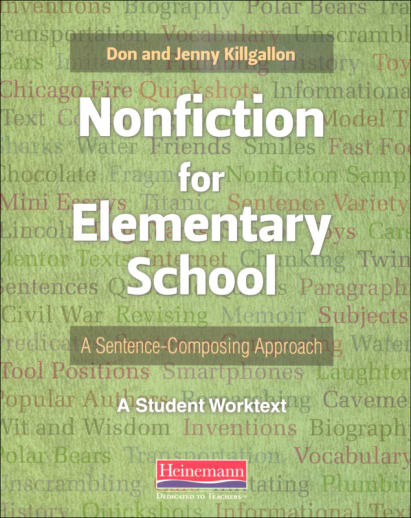A perfect melding of grammar, composition, and literature, the sentence-composing method starts with high quality sentence models from literary masters and then carefully gives students specific tools and the opportunity to practice using those tools throughout a series of books. As you would expect with any organic methodology, there is both a cohesion and an expansion through the Elementary, Middle School, and High School courses. Each are targeted with a progression of skill-building that focuses on and starts with sentences, dissects and uses grammar, and builds into composing coherent communications.
Central to all levels, is the use of writing models – sentence examples from a huge collection of best-loved and critically acclaimed writers. Think of these writers as mentors and the process of unpacking, manipulating, and imitating their sentences as a personal tutorial in the art of composition. Sentences from hundreds of writers are matched to grade level by familiarity with their works. For instance, in elementary courses you might see Katherine Patterson or Roald Dahl. In middle school it might be Jack London, Madeleine L'Engle, JK Rowling, or even Stephen King. In high school you will find Harper Lee, George Orwell, or Maya Angelou.
Multiple techniques (tools) are taught and practiced. Some of these include matching, exchanging, unscrambling, combining, imitating, expanding, and multiplying. Each tool/technique is explained and illustrated using sample sentences. Often, the underlying grammatical constructs are examined as well. The student undertakes step-by-step tasks and benefits from the clearly stated imitating expectations – and may well be surprised by the high quality of compositional results. Where possible and useful, "reference" sections in the back of books serve as an answer key.
This series has grown and matured over time. Sentence Composing was the first (late 90s); Getting Started and the other courses are a parallel series that emerged over the next two decades (2006-2020). These later sets of series expand concepts introduced in the original Sentence Composing. The Grammar series delves a little deeper into the grammar aspects (2006-2008). Paragraphs (2012-14) and Nonfiction (2015-2017) expands sentence composing techniques to particular types of composition. The newest series is the Getting Started series (2018-2020) which serves as an introduction to the sentence composing method. All volumes are by Don and Jenny Killgallon and share a focus on sentence composing (the most neglected aspect of written composition). All use model/mentors based on the belief that imitation is the conduit to originality; a needed link in creation.
It may be a little confusing to know when to use what course. In general, use the original Sentence Composing course as a summary course for a student that is in the upper level of the grade range. For instance, 4th/5th grade for the Elementary; 7th/8th grade for the Middle School. If your student is in the lower levels of the grade range (i.e. 2nd/3rd; 5th/6th) use the Getting Started book and work through the series.
Each of the sentence composing method worktexts is a stand-alone course designed to produce sentence maturity and variety and would serve as the composition/applied grammar portion of a language arts program. For elementary years, add phonics/reading, spelling, and handwriting. For middle school years, add literature and possibly a systematic grammar. For the high school years, if coupled with a literature program, the series serves as an English credit. ~ Janice

